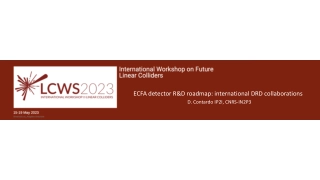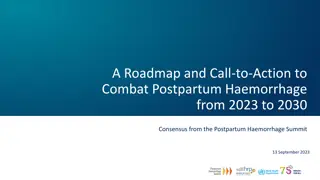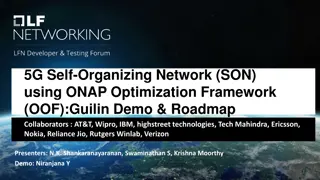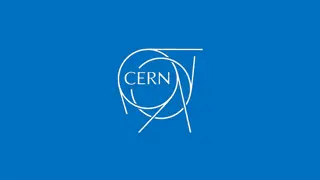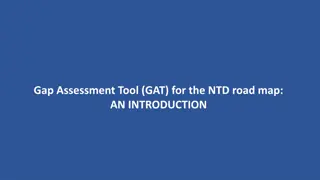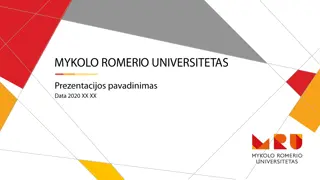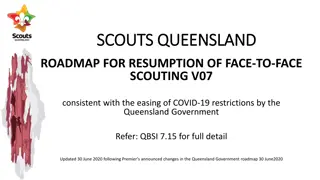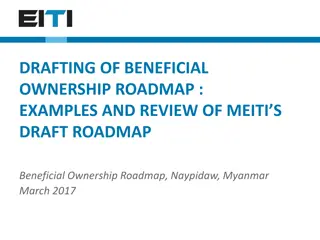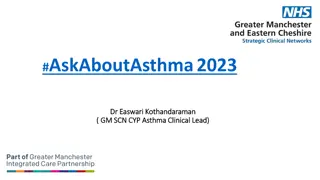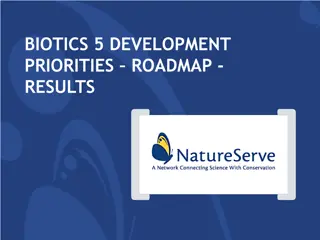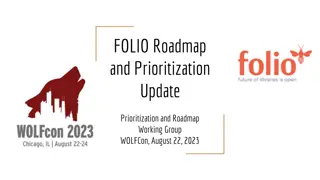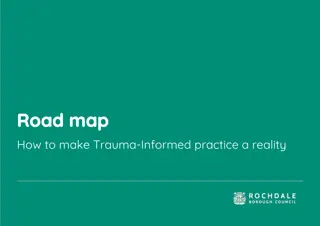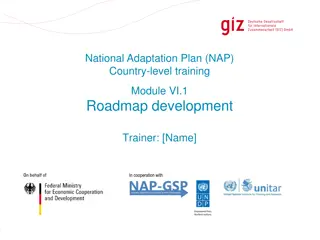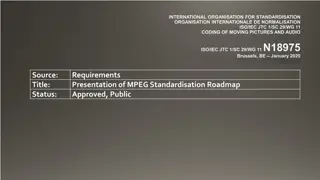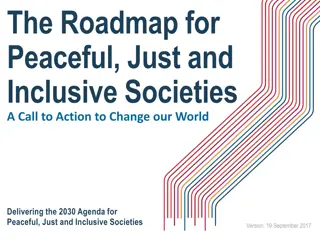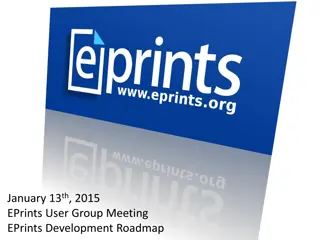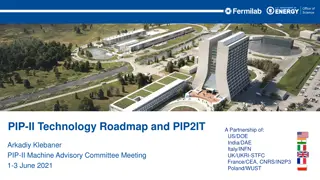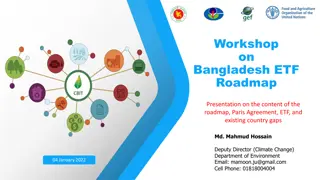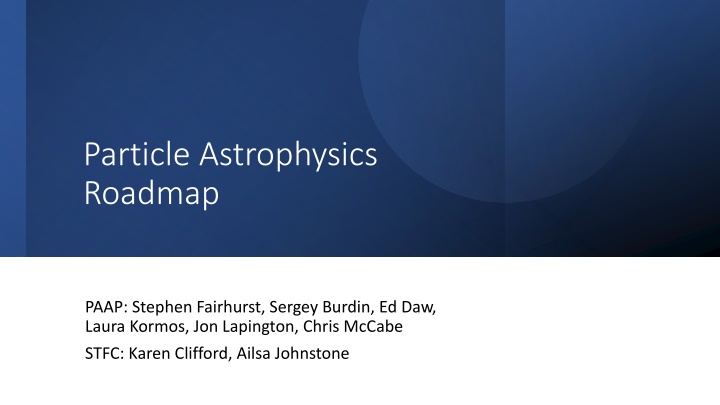
Exploring Particle Astrophysics Roadmap and Science Goals
"Discover the latest insights from the Particle Astrophysics Roadmap (PAAP) and delve into updated science goals, including the origin of the universe, multi-messenger astronomy, and dark matter discussions. Gain valuable community input and recommendations through breakout sessions and top-level summaries for a comprehensive roadmap."
Download Presentation

Please find below an Image/Link to download the presentation.
The content on the website is provided AS IS for your information and personal use only. It may not be sold, licensed, or shared on other websites without obtaining consent from the author. If you encounter any issues during the download, it is possible that the publisher has removed the file from their server.
You are allowed to download the files provided on this website for personal or commercial use, subject to the condition that they are used lawfully. All files are the property of their respective owners.
The content on the website is provided AS IS for your information and personal use only. It may not be sold, licensed, or shared on other websites without obtaining consent from the author.
E N D
Presentation Transcript
Particle Astrophysics Roadmap PAAP: Stephen Fairhurst, Sergey Burdin, Ed Daw, Laura Kormos, Jon Lapington, Chris McCabe STFC: Karen Clifford, Ailsa Johnstone
We will present top level summary of input and initial recommendations Seeking community input. Will have two breakout sessions: 1. By science theme, looking for feedback on priorities and recommendations 2. Across science theme, discussing general goals, challenges, etc Will use today s input, as well as questionnaires, proformas and other reviews to complete the draft roadmap Purpose of today s meeting
Primary Science Field 70.00% 60.00% 61.70% 50.00% PA Roadmap Input 40.00% 30.00% 20.00% 27.66% 10.00% 3.19% 3.19% 4.26% 0.00% 2016 PA Roadmap APPEC Roadmap 2017-2026 Discussions from January PA town hall Interactions with PPAP 17 completed proformas from Particle Astrophysics experiments 101 individual submissions to questionnaire Dark Matter (DM) Gravitational waves (GW) Neutrinos (Neu) Very High Energy Cosmic Microwave Background (CMB) Gama Rays (VHE) Responses Career Stage 50.00% 40.00% 43.62% 30.00% 20.00% 18.09% 10.00% 15.96% 1.06% 1.06% 13.83% 7.45% 0.00% Responses
Science Goals Update science goals to reflect progress since 2016 Directly reflect the top-level STFC science challenges https://stfc.ukri.org/research/science-challenges/ Will include CMB in the 2021 PA Roadmap, update science questions accordingly Ensure that Dark Matter discussion is sufficiently broad, reflecting current experimental efforts Update GW astronomy goals to include: primordial black holes, BH mass and spin population, neutron star structure Emphasize multi-messenger astronomy nature of particle astrophysics, including kilonova observations and origin of heavy elements
A. How did the universe begin and how is it evolving? Particle Astrophysics can help to address every question.
Mostly outside of PA, some input from solar neutrinos, heavy element formation B: How do stars and planetary systems develop B: How do stars and planetary systems develop and how do they support the existence of life? and how do they support the existence of life?
C: What are the basic constituents of matter and C: What are the basic constituents of matter and how do they interact? how do they interact? Significant input to a subset of questions
Preliminary Recommendations and Questions
Priorities Upgrades of aLIGO (to A+ and post-A+ sensitivities) and exploitation of LIGO-Virgo-KAGRA data for GW observations remain highest priority Gravitational Waves Vital that the UK retains a leading role in next generation GW observatories (Einstein Telescope and Cosmic Explorer). UK participation in the LISA mission is funded by UKSA. STFC supports preparation for science exploitation. This support must be maintained and potentially increased nearer to launch. Field has evolved significantly since 2016 from 1st detection to 100 observations of BH-BH, BH-NS and NS-NS mergers, including multi- messenger observation of neutron star merger Questions Should STFC support generic research towards next generation GW observatories, or explicitly support one of ET or CE? Does this change now that ET is included in the ESFRI roadmap? We did not receive a submission on Pulsar timing for GW observations. Is this a priority to be included in the roadmap?
PAAP 2016 DM recommendations mention LZ, G3, ADMX and Directional detector R&D. Since then, the community has grown with new initiatives and experiments being proposed. Dark Matter Strategic Review 2020 Experimental submissions: LZ (Data taking 2021 2025) DarkSide (Data taking 2024 2030) Low-mass dark matter search at Boulby (Possible timescale 2026 2030) Argo (Exploitation 2030 2040+) DarkSphere (Construction in 2024) XenonFuture (Construction in 2025) Quantum Sensor Dark Matter Projects Questions: Discussion of Dark Matter Strategic Review Recommendations DM searches in WIMP mass range Extensions to lower mass ranges: MeV and axions Alignment with PPAP roadmap How to integrate the DM searches with Quantum Sensors Dark Matter Sergey Burdin and Ed Daw
Dark Matter Strategic Review 2020 Current levels of support must be maintained and ideally expanded. Maintain and develop R&D diversity beyond the larger- scale WIMP experiments through bids for low- level seedcorn capital and resource investment. STFC should maintain and capitalise on the strong expertise and experience of direct dark matter detection research in the UK. In a limited funding climate, significant investment should only be made in a single next-generation experiment (investigate Boulby feasibility). In the short-term focus on synergies and areas of commonality in R&D in the path towards either an argon or xenon next generation experiment, for example a common R&D SiPM UK dark matter consortium. Proposals for the optimal technology for a future construction will require a strategic decision which should be taken on a similar timescale to the global prioritisation exercise in Europe and the US Dark Matter Sergey Burdin and Ed Daw
PPAP 2021 draft DM recommendations The STFC should seek opportunities to grow funding in the broad Dark Sector to support initiatives that can demonstrate their uniqueness, complementarity, or world-wide competitiveness. The UK should maintain leadership during R&D, construction and exploitation of Direct DM Detectors, and should seek opportunities to grow funding to support projects with sensitivity to low mass DM (below 1 GeV), particularly those planned to be constructed within the UK. The UK should secure future support of dark sector experiments based on successful demonstration of quantum technologies with funding outside the current STFC core programme. The UK community of theorists and phenomenologists, collider experimentalists, and direct and indirect detection experimentalists should establish an interdisciplinary programme to explore a synergic approach in DM studies, with greater communication and idea exchange. Dark Matter Sergey Burdin and Ed Daw
Theory provides crucial support for all aspects of particle- astro research (in setting directions, ensuring data is fully exploited ) Lots of concerns about funding: Concerns particle-astro theory is badly-served by current funding model: fears that world-leading research not even fully considered for funding as Astronomy says apply to Particle, and vice-versa. How widespread is this concern? All QTFP projects funded with theory support. How will this be sustained? [Through theory consolidated grants - but will the explicit link to the project remain? Is there expertise on grants panels to assess interdisciplinary QTFP-theory applications] PDRAs per funded member of academic staff is 0.17 in theory [0.69 in particle physics experiment, 0.53 in astronomy]. Concerns that it is increasingly hard to attract and keep leading PDRAs Theory Chris McCabe
Concerns raised about decoupling from EU/EU funding. Does there need to be more engagement with EuCAPT (The European Consortium for Astroparticle Theory)? Concerns raised that there is too much dispersion of knowledge across UK groups. There is a UK centre coordinating activities in particle physics (IPPP). Suggested that there should be a particle-astro centre too, possibly associated with a national lab. Is there more widespread support for this? Vertical integration is working - theorists are talking to experimentalists within the same field. Is there a desire for more cross-theory discussion (a UK version of EuCAPT)? If so, is PAAP the forum to drive that? Theory Chris McCabe
Priorities Continue the UK s leading role in CTA Maintains UK position in gamma-ray science and instrumentation Guarantee return on STFC investment Maximize community engagement with CTA Extensive UK participation in Key Science Projects Full exploitation of UK observation time Maintain expertise and leadership in gamma-ray instrumentation Continue CTA involvement beyond observatory alpha configuration e.g. Small Sized Telescope array extension, camera performance upgrade Funding for projects beyond CTA - e.g. Southern Wide-field Gamma-ray Observatory VHE Gamma- rays Jon Lapington
Recommendations CTA participation: UK involvement in CTA in construction phase Fund at the anticipated level of ~ 5M Gamma-ray science: Find a better, fairer way to fund rapidly growing PA science Currently PA science activities fall between AGP and PPGP funding Establish a ring-fenced PA specific funding pot Build on UK strengths: Maintain PA instrumentation heritage and expertise New fellowship opportunities with focus towards instrumentation Maintain expertise and skills in longer term - funding for future projects e.g. SWGO VHE Gamma- rays Jon Lapington
Very strong heritage in CMB instrumentation, analysis and theory in the UK (Planck etc.) Still great discovery potential in CMB post-Planck with high-resolution measurements of temperature and polarisation anisotropies and spectral distortion measurements Physics of the early universe/origin of structure Neutrino properties and other relativistic particles Mapping mass and gas in the universe Time-variable mm-wave sky Cosmic Microwave Background Anthony Challinor
UK priorities laid out int 2016 UK CMB white paper/roadmap Key priority: secure major UK involvement in the Simons Observatory Several previous proposals (ERC Synergy, UKRI Infrastructure Fund) unsuccessful; ~ 370k seed corn funding through PPRP About to submit PPRP proposal (~ 10M) for instrumentation, UK data centre and software pipeline development for SO STFC considering enhanced proposal for putting forward to UKRI Infrastructure Fund Other priorities: Work towards full engagement in the CMB-S4 project ($600M+ US-led project) Capitalise on major contributions to Planck by fully contributing to development and execution of future satellite missions (new opportunities now for LiteBIRD and ESA Voyage 2050 recommendations) Question: Are these priorities still appropriate, or do they need updating in 2021? Cosmic Microwave Background Anthony Challinor
None of the experiments dedicated specifically to neutrino astronomy are explicitly funded by STFC at present. Minimal funding is provided in some cases through the consolidated grants. UHE neutrinos are a key component of multi-messenger astronomy. The UK has involvement in current and future experiments: IceCube/IceCube-Gen2 from 2018 used UHE neutrinos as part of multi-messenger astronomy, identifying blazars. IceCube recently reported (Nature 591) the detection of a particle shower at the Glashow resonance at ~6 PeV. Gen2 is expected to see many more. ANITA/PUEO the most stringent constraints on UHE neutrinos with E > 1018 eV, ruling out neutrino production models and providing multi-messenger astronomy. (PUEO elected for further design study by NASA, proposed launch 2024.) Some experiments are primarily in the PP remit but also do PA SNO+ - solar neutrinos, supernovae (soon on SNEWS). SK, T2K, HK, DUNE solar and astrophysical neutrinos, diffuse neutrino background, supernovae, dark matter, CPT and Lorentz Violation. Neutrino Astronomy Laura Kormos
Other future neutrino astronomy experiments P-ONE: a new initiative for the staged construction of a multi- cubic-kilometre neutrino telescope in the deep Pacific Ocean underwater west of Victoria BC Canada. German, Canadian and US involvement, some UK involvement. Monitoring and testing of the site is ongoing. Top Priorities Funding for at least one neutrino astronomy experiment. Funding for novel technologies can be combined with UK industry expertise e.g. oceanic infrastructure, reusable energy can be related to ocean-based neutrino telescopes. Better funding for PDRAs who work on novel technologies that take more than 3 years to develop. Questions (based on PAAP surveys/previous Town Hall) Should the UK host a neutrino telescope? Should the UK host an underground PA lab including neutrinos experiment and theory group? Are there other neutrino astronomy experiments that we should be involved in? Neutrino Astronomy Laura Kormos
Todays timetable

